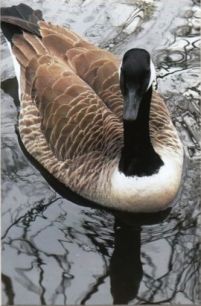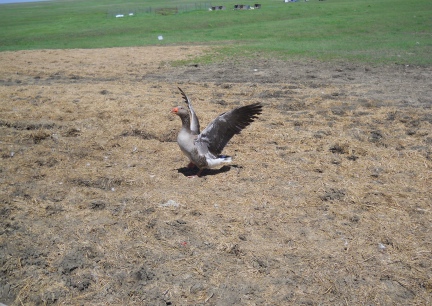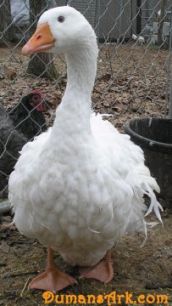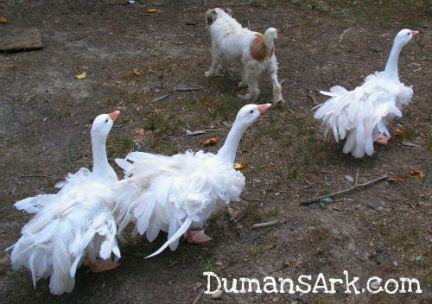|
Geese Breeds
I am hoping that this page will be not only the basics on each of the breeds, but members photos and their experiences with each breed. So please, send in your photos and paragraphs about each one. GOOSE BREEDS
There are several breeds and cross breeds of geese. A person should read up on the breed they are attracted to and make sure it will fit your life style. Some geese are better for meat, some are more broody (motherly) and some need special types of weather. Just like dogs, each breed of geese are different then another. Some folks buy their geese for looks, others for their temperament, and some for the benefits they produce. If you only want a few geese you will have to buy what the Feed Store has in for the Spring, or order from them that breed you are hoping to get.
American Buff Geese
were developed in North America. They are descendants of the wild Gray Lag goose, which is native to Europe and Northern Asia. They are a member of the Standards Medium Weight Class and have the same shape as typical European style geese. The surface plumage of the adults is an attractive fawn-apricot with a creamy white edging on each feather of the back, flanks and tail. The flighty and secondary feathers of the wings are brownish-buff. Standard weights at maturity are males-18 lbs. and females-14 lbs.
Brown African Geese are large, have a knob on the head and the same unique gray color pattern of the Brown Chinese. For many years, because of the similarity of color patterns, Brown Africans and Brown Chinese have been sold as the same breed. Toulouse goslings have a "U" at the top of the bill while Africans and Chinese have an arch. Standard weights at maturity are males-16 lbs. and females-14 lbs.
Brown Chinese Geese are an elegant, attractive, ornamental, gray variety that has become very popular for the farm goose flock. They are highly efficient foragers and maintain normal growth on a minimum amount of commercial feed. Many times they have been confused with African Geese, which are larger, and have a body carriage that is not as upright. The Toulouse paragraph has information for separating Toulouse goslings from African and Chinese goslings. Standard weights at maturity are males-10 lbs. and females-8 lbs.

Canada Geese are often kept for their stately and serene beauty. They are comfortable on land and on the water eating grass and pond weeds. The Maxima Strain of Canada geese weigh 9-13 pounds. Many people have said that their Canada geese are the best pets they have had - very calm, curious and friendly. However, you do not want to go walking up to a goose on a nest or with goslings in the wild to find out this is not true of each and everyone of them. A pet keeper may need to get a permit from the US Fish and Game in their area. You can go to our Fish and Game Office page to find your nearest office. Otherwise you can be fined for having them.
They are strong fliers and may look for greener pastures or join migrating geese unless you prevent their flight. This can be done by clipping the flight feathers in one wing annually or putting a "lid" on your flight cage.
Canada geese will pair up by year two and will start producing eggs in their third or fourth year. They are very defensive of their nest and people and pets need to be kept away during this time. They do make excellent parents and should raise a brood every year.

Embden Geese , because of their fast growth rate, large size and white feathers, Embden are the most common goose used for commercial meat production. Their feet and beak are orange but their eyes are a distinct blue. Due to their large size and breeding, they are a strong breed. At hatching time you can be quite accurate in sexing the day old goslings by looking at their coloration as the gray down in the males is lighter than in the females. As adults, however, both sexes are pure white and the only way you can determine the sex is the males are normally larger, more pompous and proud in their carriage and shriller in their voices (as with other goose breeds).
Originally bred in Germany to be tall, rangy, large geese, the Embden was refined a bit more in England to be a more compact shaped goose. Either way, Embden are the largest geese, along with the Large Dewlap Toulouse. In our experience they also produce the largest eggs for those interested in decorating eggs. The first Embden geese were imported in America in 1820 and initially called "Bremens". Their owner, James Sisso, reported these geese "lay in February and set and hatch with more certainty than the common barnyard goose, will weigh nearly, and in some case, quite twice the weight, have double the quantity of feathers, never fly, and are all of a beautiful snowy whiteness."
The Embden geese are very common-and for good reason. They are large, hardy,lay good quantities of eggs.
The photo is of our own Embden Gander named Blue. He is head of our "goose committee" that comes and gives their opinion on (talk to us in goose) everything we do outdoors. This photo was taken of him in his first year. He has since grown and is a very large bird.
Gray Saddleback Pomeranian originated in Germany. They are descendants of Geesethe Eastern branch of the Wild Gray Lag goose family. The plumage is predominantly white with the head, upper neck, shoulders, back and flanks being brownish-gray. Each colored feather of the back and flanks is edged with near-white. An adult gander may be expected to weigh about 15 pounds while a female goose will weigh about 13 pounds.
Pilgrim Geese were developed in the state of Iowa in the early 20th Century by Oscar Grow, a respected waterfowl breeder and writer. He was the first to standardize these auto-sexing geese by breeding them along set specifications. They are a member of the Standards Medium Weight Class and are the only breed of domestic geese that can be separated by gender, both as goslings and mature birds. The males are primarily white with traces of gray in the body, wings and tail while the females have a gray plumage pattern similar to Toulouse, except they are one or two shades lighter. Standard weights at maturity are males-14 lbs. and females-13 lbs.

Toulouse Geese , sometimes called "Big Gray Geese", are very popular. This breed of goose was developed in Haute Garonne, France where the city of Toulouse is the region's center. They were first exported to England in the 1840s and America in the early 1850s.
The advantage of the darker feathers is the adult birds appear neater and cleaner than a white goose if it is muddy or late in the season. Specially bred strains of Toulouse are still used in France for the production of goose foie gras, the force fed liver that is revered by chefs world wide for its smooth texture and taste.
Many people first think of Toulouse when geese are mentioned. They are fairly common, lay a good number of fertile eggs and are a sturdy, durable breed. Standard weights at maturity are males-20 lbs. and females-16 lbs.
This photo is of Tilly, our own Toulouse Goose. She is Blue's (see Embden pohoto) "best girl".
The Large Dewlap Toulouse was developed from the common Toulouse goose in the 1850's in England for exhibition/show purposes. Its unique characteristics are the large dewlap of skin hanging below their beak, a deep keel hanging from their breast and two lobes in their full paunch. These breed/strain will grow for three years.
They are a very calm breed and it is said males do not fight. Though fertility can sometimes be a problem with this breed. If you do show your Large Dewlap Toulouse you will want to get them as heavy as possible. But for the breeding season you want to keep them trim with very little extra fat on them.
French Toulouse are not an exhibition Toulouse, they are a utility goose that are very hardy and are grown commercially in France. They are fast growers and make a nice table goose in the fall. Some are hatched with tufts and are then called Tufted Toulouse.
Tufted Roman Geese have small body size and unusual head adornment. The totally pure white plumage is hard, tight and glossy. They have pinkish to reddish-orange bills that have white beans and blue eyes that are prominent and alert. Their orange to pinkish-orange, fine boned shanks are moderately short. They make excellent pets, as they are quiet, gentle and the smallest of all domesticated geese that are derivatives of the Gray lag. Standard weights at maturity are ganders-10 to 12 lbs. and females-9 to 10 lbs.
This breed of geese was credited for saving the Capitol at Rome during the siege by the Gauls in the fourth century BC. During the night, the assailants climbed to the summit, hoping to take it by surprise. The dogs slept but not the geese. The honking of the geese awakened Marcus Manlius and the intruders were repelled.
 
Sebastopol are probably our most unique appearing goose. The birds in these photos belong to Nichole Duman www.dumansark.com You would think that a bird such as this would have been bred fairly recently but actually they have been around for hundreds of years. Their origin is thought to be from the countries surrounding the Black Sea, Hungary and the Balkans. It was known early on in England as Danubian and the Spanish and Italians referred to the breed as Danubio due to importations from the lower Danube river area. How they got the name Sebastopol is a mystery other than some of the first birds may have been imported from the port of Sebastopol.
The correct colored Sebastopol is pure white. Young birds may start with a few gray feathers but gradually lose them until they are pure white at about 20 weeks after their final set of feathers. Sebastopol can stay lovely year round if you provide a mud free environment with at least a bucket of water for washing. As their feathers do not lay flat, their feathers do not insulate them as well as other breeds. Wind easily fluffs their feathers and any heat held by the feather is quickly lost. So in very cold weather they will spend more time inside than other breeds.
Fertility seems to be a problem with most Sebastopols, along with lower than normal egg production. Fertility is adequate early in the season (and they do seem to come into production earlier than most breeds) but quickly drops off.
The Sebastopol Geese in each of these lovely photos belong to Nichole Duman.
Tufted Buff Goose was developed by the late Ruth Book of Book Farms in Granby, Missouri. She crossed the Roman Tufted with the Buff and continued rebreeding the progeny until she had a buff colored goose intermediate in size and had a distinct tuft of feathers on its head.
There is a picture of a Tufted Buff in Storey Publishing's new book "Pocketful of Poultry" which has pictures of over 100 breeds of poultry.
They are a hardy breed with good egg production and fertility. The advantage of crossing two distinct breeds to create a new one is that you are producing birds with true hybrid vigor because of their diverse genetic background. They are also a pleasant breed with a charming personality.
White Chinese Goose originates in China from the wild Asiatic Swan goose. The most distinguishing feature of the Chinese and African geese is their raised knob. The knob is soft skin and not scaly, it is warm to the touch.
White Chinese are the most prolific egg laying geese and it is not unusual to have them lay in the fall or winter.
The earliest record of Chinese geese in American is in the correspondence of George Washington. It discloses that in 1788 he received from Governor Morris two Chinese pigs and with them "a pair of white Chinese geese, which are really the foolishest geese I ever beheld; for they choose all times for setting but in the Spring and one of them is even now (November) actually engaged in that business." In 1850 Mr. Nolan wrote "It is a beautiful variety , next in size to the African and approaches nearest to the swan of any other goose. It is snow white, knobbed on the beak with orange legs, and truly ornamental on a sheet of water." The Brown Chinese goose is smaller than the white with identical coloring to the African goose.
Chinese geese, like Africans, are a more talkative breed of geese. Due to this characteristic, they are the best breed if you want to be alerted to intruders or other strange occurrences.
Chinese geese, due to their smaller size and agility, may be the best for weeding purposes, they love to eat grass. They have been used commercially to rid cotton orchards, mint and other crops of grasses. If you want them to eat broad leaf weeds, you will need to train them by supplying them cuttings of the targeted weed starting at one week of age until you let them out. Otherwise they will eat the grass and leave the broad leaf plants unless they become very hungry.
Mixed Breeds Of Course, the Mixed Breeds. Mixed Bred Geese, like mixed breed dogs or cats, can be anything and have the personality and looks of any of their ancestors.
(more to come)
HOPEFULLY THIS PAGE WILL BE A WORK IN PROGRESS, PLEASE COME BACK WE MIGHT HAVE MORE PHOTOS AND INFORMATION FOR YOU TO SEE.
|




 In the high plains of South Dakota, USA
In the high plains of South Dakota, USA In the high plains of South Dakota, USA
In the high plains of South Dakota, USA